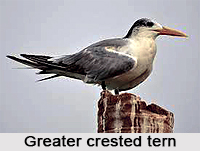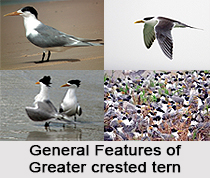 Greater Crested Tern is an Indian bird, that bears a scientific name "Thalasseus bergii", also called crested tern or swift tern, is a seabird in the tern family that nests in dense colonies on coastlines and islands in the tropical and subtropical Old World.
Greater Crested Tern is an Indian bird, that bears a scientific name "Thalasseus bergii", also called crested tern or swift tern, is a seabird in the tern family that nests in dense colonies on coastlines and islands in the tropical and subtropical Old World.
Breeding Season of Greater Crested Tern
The subspecies of Greater Crested Tern breed in the area from South Africa around the Indian Ocean to the central Pacific and Australia, all populations dispersing widely from the breeding range after nesting. This large tern is closely related to the royal and lesser crested terns, but can be distinguished by its size and bill colour.
Structure of Greater Crested Tern
Greater Crested Tern has grey upperparts, white under parts, a yellow bill and a shaggy black crest that recedes in winter. They are gull-like in appearance, but typically have a lighter build, long pointed wings (which give them a fast, buoyant flight), a deeply forked tail and short legs. Its young have a distinctive appearance, with strongly patterned grey, brown and white plumage, and rely on their parents for food for several months after they have fledged.
Adaptability of Greater Crested Tern
Greater Crested Tern is an adaptable species that has learned to follow fishing boats for jettisoned bycatch, and to use unusual nest sites such as the roofs of buildings and artificial islands in salt pans and sewage works.
Eggs of Greater Crested Tern
The eggs and young of Greater Crested Tern are taken by gulls and ibises, and human activities such as fishing, shooting and egg harvesting have caused local population declines. There are no global conservation concerns for this bird, which has a stable total population of more than 500,000 individuals.
Description of Greater Crested Tern
Greater Crested Tern was originally described as Sterna bergii by German naturalist Martin Lichtenstein in 1823, but was moved to its current genus, Thalasseus, after mitochondrial DNA studies confirmed that the three main head patterns shown by terns.
Geographical Races of Greater Crested Tern
Greater Crested Tern has about five geographical races, differing mainly in the colour of the upperparts and bill. These are listed below in taxonomic sequence. A similar number of other potential subspecies have been proposed, but are not considered valid.
Size of Greater Crested Tern
Greater crested tern is a large tern with a long 5.4-6.5 cm yellow bill, black legs, and a glossy black crest that is noticeably shaggy at its rear. The breeding adult of the nominate subspecies T. B. bergii is 46-49 cm long, with a 125-130 cm wing-span; this subspecies weighs 325-397 gram. The forehead and the under parts are white, the back and inner wings are dusky-grey. In winter, the upperparts plumage wears to a paler grey, and the crown of the head becomes white, merging at the rear into a peppered black crest and mask.
 Sexes of Greater Crested Tern
Sexes of Greater Crested Tern
The adults of Greater Crested Tern of both sexes are identical in appearance, but juvenile birds are distinctive, with a head pattern like the winter adult, and upperparts strongly patterned in grey, brown, and white; the closed wings appear to have dark bars. After moulting, the young terns resemble the adult, but still have a variegated wing pattern with a dark bar on the inner flight feathers.
Voice of Greater Crested Tern
Greater Crested Tern is highly vocal in nature, especially at its breeding grounds.
Concentration of Greater Crested Tern
Greater Crested Tern occurs in tropical and warm temperate coastal parts of the Old World from South Africa around the Indian Ocean to the Pacific and Australia. Greater Crested Tern breeds on many islands in the Indian Ocean including Aldabra and Etoile in the Seychelles, the Chagos Archipelago, and Rodrigues.



















